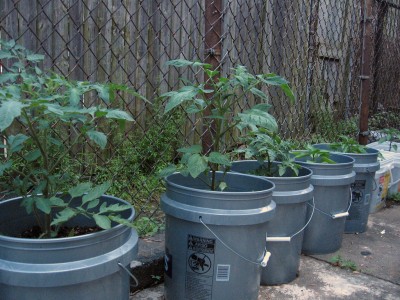
Container planting vegetables is not a new concept, but what about using buckets for growing vegetables? Yes, buckets. Keep reading to learn more about how to grow vegetables in a bucket.
Why Plant Vegetables in a 5-Gallon Bucket?
You don’t need a huge backyard to grow food for your family. In fact, you don’t even need a backyard at all. More and more people are container planting vegetables and getting plenty of food. In addition to saving space, using buckets for gardens also helps with a lot of other common gardening problems like young plants getting trampled, rabbits eating plants, poor soil, hard rains, weeds, and ease of care.
While raised beds can solve many of these problems, they are more expensive and require more room. Another great benefit of growing vegetables in buckets is that they are portable. If your tomato is not getting enough sun in a certain area, simply pick it up and put it somewhere else. You will not have to dig up, replant and risk killing your tomato; you will only be moving the container it is in.
Growing Vegetables in Buckets
Here are just some of the plants that grow well in a 5-gallon bucket, and how many of them can be grown in one:
- Tomatoes – Cherry or bush tomatoes work best. Plant only 1 tomato per bucket. Drive a stake in the middle to support the plant
- Cucumbers – Plant 1 per bucket
- Melons – Plant 1 per bucket
- Squash – Plant 1 per bucket
- Eggplant – 1 per bucket
- Peppers – 2 per bucket
- Beans – Bush kinds work best. Plant 3 per bucket
- Onions – Plant 4 per bucket
- Lettuce – Plant 4 per bucket
- Beets – Plant 4 per bucket
- Carrots – Plant 10 per bucket
- Radishes – Plant 10 per bucket
Many herbs also grow very well in buckets. One plant will spread to fill the entire container.
How to Grow Vegetables in a Bucket
These simple guidelines will help with growing vegetables in buckets:
- Purchase or acquire several 5-gallon buckets. These buckets can be purchased at your local home improvement store for a low cost, or salvaged from a dumpster. Do not use one that has been used for toxic chemicals or materials. If you are concerned about using “food grade” plastic buckets, check at local restaurants. Many bulk restaurant food supplies are delivered in 5 gallon food grade buckets and many restaurants are happy to give them away.
- Make holes in the bottom for drainage. You will want plenty of holes for this, as water can accumulate in a small container quickly. Use a drill or punch holes with a nail and hammer. One hole every 3 inches is a good amount.
- Paint the bucket for a nicer appearance. Spray painting for a solid color is the easiest method, but stripes and polka-dots can help dress up your patio. If you are not in the mood for painting, drape some outdoor fabric around the bucket and tie it with a piece of twine for a classy and effortless look.
- Place some gravel in the bottom of the bucket. This will help with drainage – about 2-3 inches of small rocks should work fine.
- Fill the rest of the bucket up with an even mixture of peat moss, planting soil, and compost. Mix the dirt well and leave a little room for planting. Some plants may require higher or lower amounts of compost in the soil. Do not use garden soil or top soil as these can compact in the bucket and hinder plant growth.
- Place your plants. Use established plants or seeds. Both methods work well with container gardening.
- Water daily during dry spells and only when the soil is dry other times. Fertilize plants once or twice a month with liquid fertilizer for best results.






